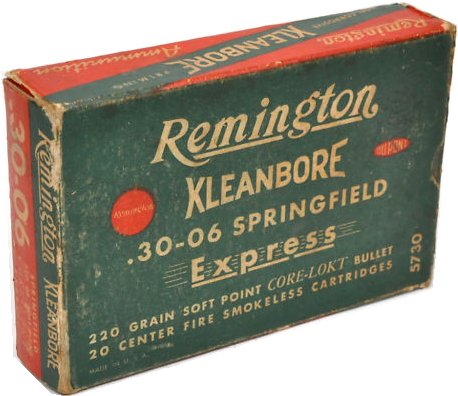Difference between revisions of "Loads, Grains, and Bullets"
m |
m |
||
| Line 4: | Line 4: | ||
If you purchase a box of a .30-06 rifle cartridges you will note that the load is marked on the box described by grains. | If you purchase a box of a .30-06 rifle cartridges you will note that the load is marked on the box described by grains. | ||
| − | [[Image:30-06riflecartridges.jpg]] | + | [[Image:30-06riflecartridges.jpg]]<BR> |
| + | '''Illustration: 220 grain bullet weight''' | ||
The box of cartridges in the illustration above from the 1950's describes a 220 grain soft point bullet. This refers to the weight of the bullet and not how much gunpowder is in the cartridge case. The original M1906 .30-06 cartridge consisted of a 150 grain jacketed bullet. After WWI the weight of the bullet was increased to 173 grain for military use. Contemporary .30-06 bullet weights range from 110 to 220 grains. | The box of cartridges in the illustration above from the 1950's describes a 220 grain soft point bullet. This refers to the weight of the bullet and not how much gunpowder is in the cartridge case. The original M1906 .30-06 cartridge consisted of a 150 grain jacketed bullet. After WWI the weight of the bullet was increased to 173 grain for military use. Contemporary .30-06 bullet weights range from 110 to 220 grains. | ||
Revision as of 17:22, 19 April 2011
With modern firearms the term "grains" refers to weight. The term itself is a throwback to the black powder era. On a box of ammunition cartridges the term "grains" describes the weight (mass) of the bullet. In the most simplified terms, lighter bullets (lower grains number) are accurate at short to medium range while heavy bullets (higher grains number) are better at retaining energy at longer distances.
If you purchase a box of a .30-06 rifle cartridges you will note that the load is marked on the box described by grains.

Illustration: 220 grain bullet weight
The box of cartridges in the illustration above from the 1950's describes a 220 grain soft point bullet. This refers to the weight of the bullet and not how much gunpowder is in the cartridge case. The original M1906 .30-06 cartridge consisted of a 150 grain jacketed bullet. After WWI the weight of the bullet was increased to 173 grain for military use. Contemporary .30-06 bullet weights range from 110 to 220 grains.
When speaking in terms of gun powder, the amount of powder, also expressed in grains, has a lot to do with the type of powder used. There's a variety of modern smokeless powder types with various burn rates for various application types. Faster burning powder achieves high velocities with less powder while with slower burning powder the charge, or powder load in grains, may be increased. It is generally very dangerous to load a cartridge case to full capacity with any modern smokeless powder, especially the faster burning types.
Ammo manufacturers readily share the bullet weight in grains in their advertising, but rarely give details about what type of powder is being used and the powder weight in grains. Different ammo manufacturers use different types of powder and different powder charges. Although ammo with a heavier bullet weight will tend to have a hotter powder load (more powder or faster burning) this is not always necessarily true.
Remember, you can achieve a more powerful powder load by using a faster burning powder, or increasing the amount of powder in the load. Using near or at the maximum powder load that is safe to fire in a gun is called "loading hot." Hot loads are more powerful, which causes more recoil (kick) and the bullet will strike with more energy. However, ammunition hot will shorten the life of your firearm in increase your risk of injury.